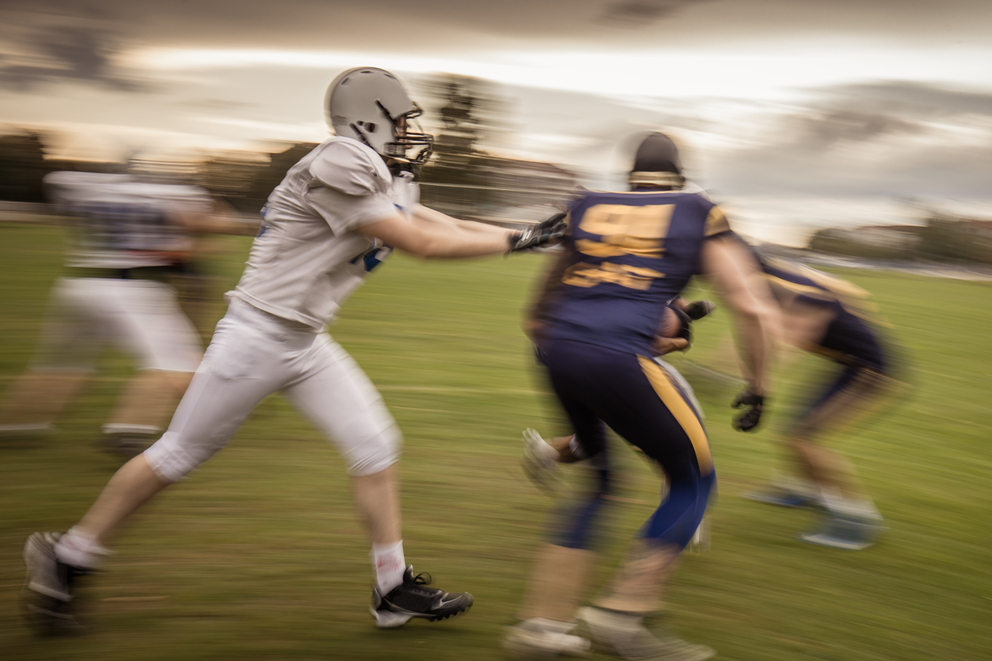
Researchers at Penn State are in the midst of a multi-year research study that seeks to examine the consequences of head acceleration events and their relationship to the disruption of normal brain development.
The investigators also seek to identify any critical threshold between subconcussive blows — impacts that fall below the concussion threshold but players may experience on a daily basis — with those of full-blown concussive injury in order to more accurately measure the effects of subconcussive injuries throughout an athletic season.
Semyon Slobounov, professor of kinesiology at Penn State, is leading the interdisciplinary effort which assesses student-athletes and collects data before, during, and after multiple football seasons.
“There are several challenges that need to be explored in concussion research and clinical practice,” according to Slobounov. “This research program utilizes a combination of evaluation procedures and measures using pre- and post-concussion and subconcussive testing of the same subjects, and does so across multiple years."
By examining the relationship between cognitive measures, blood biomarkers, and basic brain functions in student-athletes over time, Slobounov and colleagues hope to identify student-athletes who are at high risk for concussions and, ultimately, reduce the risk of concussive injuries.
The researchers gather data from multiple functional and biological markers in collegiate football players prior to, during, and after each of three football seasons.
Prior to contact practices commencing, student-athletes complete a standardized assessment of concussion which involves assessments of orientation, immediate memory, concentration, delayed recall, and simple neurological observations.
Student-athletes also participate in a virtual reality tasks which measure balance, spatial navigation, and reaction time.
“Balance, spatial navigation, and reaction time are three major categories affected by concussive injury,” Slobounov stated. “These tests are valid and sensitive capable to detect positive brain disfunctions in ‘clinically asymptomatic’ subjects.”
When practice begins, an accelerometer is fitted and placed into participant’s helmets and the sensor stays inside the helmet for the duration of the study. The accelerometer monitors the hits that the subjects’ experience while they are wearing their athletic helmets during practice.
In addition to assessments, virtual reality sessions, and accelerometer readings, student-athletes undergo a structural and functional MRI scans, provide a small blood samples to examine levels of miRNA and additional biomarkers, and other clinical data.
Researchers are measuring any observed changes in brain functions (e.g., memory, balance, reaction time etc.,) in student-athletes as a result of multiple blows to the head, or simply just the result of high intensity of physical activity during the season — including subconcussion events.
“There are a lot of speculations and concerns that both concussive and even subconcussive blows in the head may lead to development of CTE or other neurological disorders, such as Parkinsonism, etc.,” said Slobounov. “Our ongoing studies may partly contribute to further understanding the situation and reduce parents’ and others’ concerns about safety in collision sports.”
Data for year one of the study, which was collected from 30 participating football players, has been completed and is currently under analysis. The same protocol will be implemented in two more upcoming football seasons, the result of which will produce a significant data set to help understand and prevent the impact of concussions on the lives of individuals.
Penn State assistant athletic trainer Tesa Johns monitored head acceleration events throughout the entire football season.
In its next phase, an additional effort led by David Vandenbergh, professor of biobehavioral health at Penn State, will explore genetic contributions to resilience versus susceptibility and high risk for brain injury after high acceleration events.
Dr. Wayne Sebastianelli, director of athletic medicine at Penn State, along with Dr. Pete Seidenberg of Penn State Sports Medicine, are co-investigators of the study.
This research project is supported by the NCAA and U.S. Department of Defense CARE Consortium (Concussion Assessment, Research and Education Consortium), which supports research to more accurately diagnose, treat, and prevent concussion among NCAA student-athletes, service men and women, and the broader public.
In addition, the study is also supported by the Derek Sheely Foundation, which was created to increase awareness and research of concussions and traumatic brain injuries, with a focus on youth sports.
A range of neuroscience experts and clinical researchers who have a specific focus on various neurological and neuropsychological disorders may also benefit from the major findings of this study, according to Slobounov.